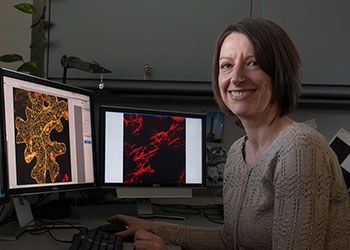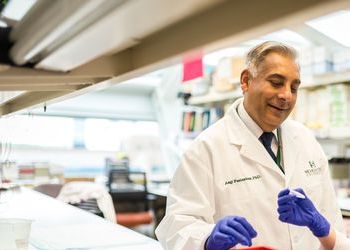Illuminating Solutions
Researcher finds joy, happiness in the process of discovery
Illuminating Solutions
Researcher finds joy, happiness in the process of discovery
April 28, 2015Every day, researcher Robert Abramovitch enters his lab in the Physical Sciences building motivated and ready to find new solutions for treating tuberculosis (TB).
Abramovitch, an assistant professor in the Department of Microbiology and Molecular Genetics, steps with energy and passion.
When he and his team look through their microscopes or at data on a computer screen, they see all sorts of colors: orange, red, pink, yellow.
But the most exciting color? Green.
“We’ve engineered a TB strain to glow bright green to indicate when it is being attacked by the immune system,” Abramovitch said. “We then used this strain to find chemical compounds that turn off the green fluorescence of the bacterium. We believe these chemical compounds will blind the bacterium from an oncoming immune system assault.”
Essentially, it tricks the bacteria so it can be combatted from another path.
Once a major problem in the U.S., TB affects most of the world’s populations. It is highly contagious and sometimes, can become multi-drug resistant; a rogue super-bacteria that dodges (then attacks) the immune system’s natural defenses.
“We have to really believe that we can make something happen in the near-term because it’s an immediate problem,” Abramovitch added. “Someone dies of TB somewhere in the world every 20 seconds. We are trying to make progress and move as fast as we can, to address this global health issue.”
Having sifted through roughly 890,000+ compounds, Abramovitch has found several interesting things—some of which have led to new, undiscovered aspects of TB’s biology. The team has found clues of the directions they’d like to go treatment-wise, and could literally be on the verge of discovering drugs that can be taken into clinical trials.
On one hand, there exists an urgency to find the solutions. On the other, the progress is slow and costly, and, like many academic researchers, they must be patient. Increased funding could get them to the answers faster.
“Sometimes it’s even small amounts of seed funding that allow you to do one or two more experiments,” Abramovitch said. “Sometimes it’s that last piece of important data that puts you over the top and gets you that long-term grant.”
Abramovitch and his team are determined to find new TB treatments. They will not let up until they have found what they are seeking, and their trained eyes will know when they find it.
So for these Spartan researchers, green is the color of hope.
Learn more about supporting important, life-saving research like Abramovitch’s.
Author: Sarah Wardell




